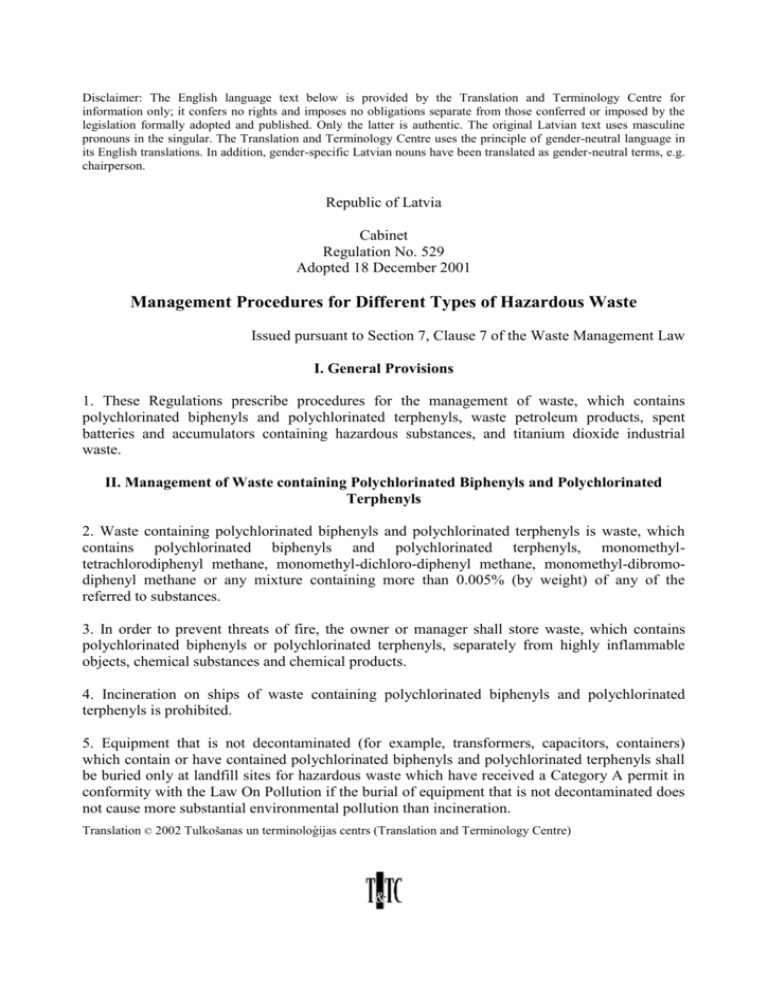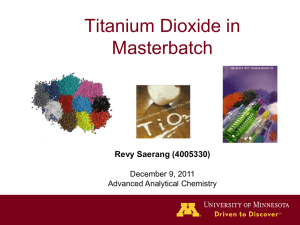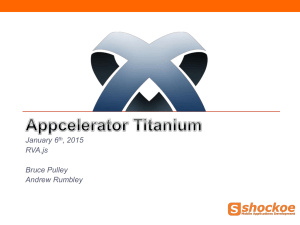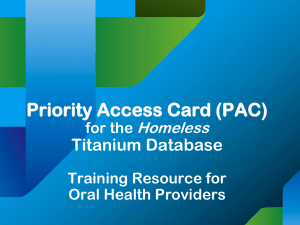Republic of Latvia Cabinet Regulation No. 529 Adopted 18
advertisement

Disclaimer: The English language text below is provided by the Translation and Terminology Centre for information only; it confers no rights and imposes no obligations separate from those conferred or imposed by the legislation formally adopted and published. Only the latter is authentic. The original Latvian text uses masculine pronouns in the singular. The Translation and Terminology Centre uses the principle of gender-neutral language in its English translations. In addition, gender-specific Latvian nouns have been translated as gender-neutral terms, e.g. chairperson. Republic of Latvia Cabinet Regulation No. 529 Adopted 18 December 2001 Management Procedures for Different Types of Hazardous Waste Issued pursuant to Section 7, Clause 7 of the Waste Management Law I. General Provisions 1. These Regulations prescribe procedures for the management of waste, which contains polychlorinated biphenyls and polychlorinated terphenyls, waste petroleum products, spent batteries and accumulators containing hazardous substances, and titanium dioxide industrial waste. II. Management of Waste containing Polychlorinated Biphenyls and Polychlorinated Terphenyls 2. Waste containing polychlorinated biphenyls and polychlorinated terphenyls is waste, which contains polychlorinated biphenyls and polychlorinated terphenyls, monomethyltetrachlorodiphenyl methane, monomethyl-dichloro-diphenyl methane, monomethyl-dibromodiphenyl methane or any mixture containing more than 0.005% (by weight) of any of the referred to substances. 3. In order to prevent threats of fire, the owner or manager shall store waste, which contains polychlorinated biphenyls or polychlorinated terphenyls, separately from highly inflammable objects, chemical substances and chemical products. 4. Incineration on ships of waste containing polychlorinated biphenyls and polychlorinated terphenyls is prohibited. 5. Equipment that is not decontaminated (for example, transformers, capacitors, containers) which contain or have contained polychlorinated biphenyls and polychlorinated terphenyls shall be buried only at landfill sites for hazardous waste which have received a Category A permit in conformity with the Law On Pollution if the burial of equipment that is not decontaminated does not cause more substantial environmental pollution than incineration. Translation © 2002 Tulkošanas un terminoloģijas centrs (Translation and Terminology Centre) III. Management of Waste Petroleum Products 6. Waste petroleum products are any lubricating oils of mineral origin and industrial oils (for example, used internal combustion engine oils and gear-box oils, mineral oils, turbine oils and hydraulic oils which have become unfit for the initially intended use). 7. After receipt of a permit in accordance with procedures prescribed in regulatory enactments, the manager or owner of petroleum product waste shall perform the following activities with the waste: 7.1. recovery; 7.2. incineration; or 7.3. waste storage control or waste burial in accordance with procedures prescribed in regulatory enactments. 8. The recovery process of waste petroleum products must not negatively affect human health and the environment. Petroleum products produced in the recovery process may not contain hazardous waste. The concentration of polychlorinated biphenyls and polychlorinated terphenyls in recovered petroleum products may not exceed 50 parts per million. 9. The recovery of waste petroleum products containing polychlorinated biphenyls and polychlorinated terphenyls is permitted if after the recovery process it is possible to separate polychlorinated biphenyls and polychlorinated terphenyls, or the content of polychlorinated biphenyls and polychlorinated terphenyls after recovery is less than 50 parts per million. 10. The following is prohibited: 10.1. disposal of waste petroleum products in internal watercourses, bodies of water, underground waters, the sea and sewage systems; 10.2. burial of residues, which are produced after treatment of waste petroleum products, in sites that are not intended for waste burial; 10.3. the treatment of petroleum products in such a way as causes air pollution exceeding emission limits set out in a Category A permit or Category B permit to perform activities, or in a permit on emission of air pollutants from stationary air pollution sources; and 10.4. the mixing of petroleum products with polychlorinated biphenyls or other hazardous waste. 11. Owners of waste petroleum products, who create more than 500 litres of waste petroleum products per year, and managers of waste petroleum products shall record the amount of created, received or delivered waste petroleum products, the quality, origin, location, and the date of transfer and receipt of such products, in a register or another data medium (for example, in a database) and once a year (for the previous year) submit this information to the regional environmental board and local government, in the administrative territory of which the activities referred to are conducted. Translation © 2002 Tulkošanas un terminoloģijas centrs (Translation and Terminology Centre) 2 12. The regional environmental board shall send the information received to the Latvian Environment Agency. The Latvian Environment Agency shall compile the information referred to and ensure that it is available to the public. IV. Management of Batteries and Accumulators containing Hazardous Substances 13. A battery or accumulator containing hazardous substances is a source of electrical energy, in which source energy is produced upon direct transformation of chemical energy and which source consists of one or more primary (non-rechargeable) or secondary (rechargeable) parts (hereinafter - battery or accumulator). 14. Traders, who sell batteries or accumulators shall ensure that spent batteries or accumulators are accepted from consumers free of charge, irrespective of whether the buyer has purchased the batteries or accumulators in the undertaking concerned or elsewhere. Traders of batteries and accumulators shall ensure safe temporary storage of collected spent batteries and accumulators, as well as transfer to a manager of a facility for processing or burial equipment. 15. The manager of a facility for processing or burial shall submit information quarterly, on the quantity of batteries and accumulators collected, processed and buried, to the regional environmental board and local government in the administrative territory of which the relevant facility is located. V. Management of Titanium Dioxide Industrial Waste 16. Titanium dioxide industrial waste is any residuals produced in the manufacturing process of titanium dioxide which the owner disposes, intends to dispose or is forced to dispose. 17. Disposing of titanium dioxide industrial waste in land surfaces, the Baltic Sea or underground waters, as well as burying them at sea or in subterranean depths is prohibited. 18. Management of titanium dioxide industrial waste is prohibited if an immediate or accumulating effect is possible on the water environment and fish resources. 19. In order to obtain a waste management permit or a permit for A or B category activities, a manager of titanium dioxide industrial waste, in addition to the requirements prescribed in regulatory enactments, shall submit to a regional environmental board information regarding: 19.1. the accumulation and bio-transformation capacity of titanium dioxide industrial waste in biological materials or sediment; 19.2. the sensitivity of titanium dioxide industrial waste to physical, chemical or biochemical modifications and possible interaction in the environment with other organic and inorganic materials; 19.3. the possibility of causing harm to natural resources or to negatively affect natural resources; and Translation © 2002 Tulkošanas un terminoloģijas centrs (Translation and Terminology Centre) 3 19.4. preventive measures to avoid environmental pollution with titanium dioxide industrial waste (direct or indirect disposal of titanium dioxide industrial waste, due to human actions, which can cause a threat to human health, negatively affect the environment (for example, ecosystems, landscapes and specially protected nature territories) or hinder utilisation of natural resources in conformity with their purpose). 20. A manager of a titanium dioxide industrial waste burial facility shall once a month monitor the waste and the environment affected (for example, waters, soil, subterranean depths, air into which the titanium dioxide industrial waste is emitted) and not less than once a quarter shall report the results to the regional environmental board and local government in the territory of which the relevant facility is located. 21. Titanium dioxide industrial waste monitoring shall include examination of the quantity, contents and toxicity of waste in order to ascertain conformity with the requirements set out in the relevant permit. 22. Monitoring of the environment affected by titanium dioxide industrial waste includes the following examinations: 22.1. visual examination (once a year): 22.1.1. topography and management of the burial site; 22.1.2. effect on the subterranean depths; 22.1.3. general ecological situation of the burial site; and 22.1.4. overall changes; 22.2. chemical examination: 22.2.1. acidity; 22.2.2. iron content (liquids and as particles); 22.2.3. calcium content; 22.2.4. toxic metals content, if any (liquids and as particles); and 22.2.5. the sulphur dioxide and dust background in the air. 23. Requirements for sampling of titanium dioxide waste located in tumulus or buried, specifications to be measured, minimum frequency of sampling and analyses, and the methods of monitoring analyses are specified in the Annex of these Regulations. 24. On the basis of a request of the regional environmental board, in addition to the specifications referred to in the Annex to these Regulations, samples of unfiltered underground water shall be taken to determine the quantity (milligrams/litre) of vanadium, manganese, nickel, zinc using the atomic absorption spectrophotometry method, or to determine the quantity (milligrams/litre) of chromium using the molecular absorption spectrophotometry method. 25. Methods of titanium dioxide industrial waste monitoring and analyses, sampling vessels and containers, storage methods of samples taken, transportation of samples, conditions of storage and preparation for the conduct of analyses shall ensure comparability of the results. Translation © 2002 Tulkošanas un terminoloģijas centrs (Translation and Terminology Centre) 4 26. Samples and the results of analyses shall be recorded in a register or other data medium, which shall be available to State environment inspectors and authorised persons of the local government in the territory of which the facility for titanium dioxide industrial waste burial is located. VI. Closing Provisions 27. Paragraphs 14 and 15 of these Regulations come into force on 1 January 2003. Prime Minister A. Bērziņš Minister for Environmental Protection and Regional Development V. Makarovs Translation © 2002 Tulkošanas un terminoloģijas centrs (Translation and Terminology Centre) 5 Annex Cabinet Regulation No. 529 18 December 2001 Requirements for Sampling of Titanium dioxide Waste, in Tumulus or Buried, Parameters to be Measured, Minimum Number of Samples and Analyses, and Methods of Analyses Purpose of examination and requirements for sampling 1. Unfiltered surface water near waste landfill sites in places that may be affected and outside, especially in places where water flows out from waste disposal sites. Samples shall be taken at one and the same time, as far as possible, at a depth of 50 cm 2. Unfiltered underground water surrounding waste landfill sites in places that may be affected and outside such sites, especially in places where water flows out from waste disposal sites. Samples shall be taken at one and the same time. Parameters Minimum number of samplings and analyses (per year) pH 1 SO4 (mg/l) 1 Ti (mg/l) Fe (mg/l) 1 Ca (mg/l) 1 Cu, Pb (mg/l) 1 Cl (mg/l) 1 1 Method of analysis Electrometry Measurements shall be done during the taking of samples Gravimetry Complexometric titration Molecular absorption spectrophotometry Atomic absorption spectrophotometry. Atomic absorption spectrophotometry Molecular absorption spectrophotometry. Atomic absorption spectrophotometry. Complexometric titration. Atomic absorption spectrophotometry. Complexometric titration. Titrimetry (Mohr's method) Minister for Environmental Protection and Regional Development Translation © 2002 Tulkošanas un terminoloģijas centrs (Translation and Terminology Centre) V. Makarovs 6







